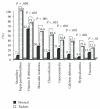Nutritional Rickets among Children in a Sun Rich Country
- PMID: 21048925
- PMCID: PMC2965426
- DOI: 10.1155/2010/410502
Nutritional Rickets among Children in a Sun Rich Country
Abstract
Objective. This study describes the magnitude and characteristics of nutritional rickets and associated risk factors among children in Qatar. Subjects. A consecutive sample of 730 healthy subjects who visited the primay health care clinics were approached and 540 (73.9%) subjects gave consent. Mehods. Nutritional rickets diagnosis was based on clinical radiologic and biochemical parameters and normalization of alkaline phosphatase level after 6 weeks course of daily vitamin D therapy. Results. The study revealed that 23.9% of the studied children had nutritional rickets. The mean ± SD age of those with rickets (3.76 years ± 1.51) was slightly higher than those without rickets (3.57 years ± 1.45). Family history of vitamin D deficiency (44.2%; P = .001) and diabetes mellitus (53.5%; P = .002) were significantly higher in rachitic children than in nonrachitic children. The children with rickets spent a significantly shorter average duration (26.86 minutes ± 19.94) under the sun than those without rickets (30.59 minutes ± 15.72; P < .001). A significantly larger proportion of rachitic children was afflicted with vitamin D deficiency (75.2% versus 62.2%; P < .001), secondary hypothyroidism (100% versus 7.5%; P = .009) and muscular weakness (56.6% versus 26.3%; P < .001). Conclusion. The most important risk factors were low vitamin D and calcium intakes, lack of exposure to sunlight, prolonged breast feeding without supplementation of vitamin D.
Figures
Similar articles
-
Vitamin D deficiency in healthy children in a sunny country: associated factors.Int J Food Sci Nutr. 2009;60 Suppl 5:60-70. doi: 10.1080/09637480802400487. Epub 2008 Oct 22. Int J Food Sci Nutr. 2009. PMID: 18946796
-
Role of calcium deficiency in development of nutritional rickets in Indian children: a case control study.J Clin Endocrinol Metab. 2012 Oct;97(10):3461-6. doi: 10.1210/jc.2011-3120. Epub 2012 Aug 14. J Clin Endocrinol Metab. 2012. PMID: 22893720
-
High prevalence of vitamin D deficiency in young children in a highly sunny humid country: a global health problem.Minerva Pediatr. 2009 Feb;61(1):15-22. Minerva Pediatr. 2009. PMID: 19179999
-
Nutritional rickets & osteomalacia: A practical approach to management.Indian J Med Res. 2020 Oct;152(4):356-367. doi: 10.4103/ijmr.IJMR_1961_19. Indian J Med Res. 2020. PMID: 33380700 Free PMC article. Review.
-
Nutritional rickets in immigrant and refugee children.Public Health Rev. 2016 Jul 22;37:3. doi: 10.1186/s40985-016-0018-3. eCollection 2016. Public Health Rev. 2016. PMID: 29450045 Free PMC article. Review.
Cited by
-
Evaluation of serum 25-Hydroxy vitamin D levels in children with autism Spectrum disorder.Ital J Pediatr. 2018 Dec 17;44(1):150. doi: 10.1186/s13052-018-0587-5. Ital J Pediatr. 2018. PMID: 30558646 Free PMC article.
-
Editorial: Global excellence in children and health.Front Public Health. 2023 Sep 14;11:1286481. doi: 10.3389/fpubh.2023.1286481. eCollection 2023. Front Public Health. 2023. PMID: 37780439 Free PMC article. No abstract available.
-
The impact of rickets on growth and morbidity during recovery among children with complicated severe acute malnutrition in Kenya: A cohort study.Matern Child Nutr. 2018 Apr;14(2):e12569. doi: 10.1111/mcn.12569. Epub 2017 Nov 27. Matern Child Nutr. 2018. PMID: 29178404 Free PMC article. Clinical Trial.
-
Iron and vitamin D levels among autism spectrum disorders children.Ann Afr Med. 2017 Oct-Dec;16(4):186-191. doi: 10.4103/aam.aam_17_17. Ann Afr Med. 2017. PMID: 29063903 Free PMC article.
-
Is high prevalence of Vitamin D deficiency evidence for autism disorder?: In a highly endogamous population.J Pediatr Neurosci. 2014 Sep-Dec;9(3):227-33. doi: 10.4103/1817-1745.147574. J Pediatr Neurosci. 2014. PMID: 25624924 Free PMC article.
References
-
- Welch TR, Bergstrom WH, Tsang RC. Vitamin D-deficient rickets: the reemergence of a once-conquered disease. Journal of Pediatrics. 2000;137(2):143–145. - PubMed
-
- Wagner CL, Greer FR. Prevention of rickets and vitamin D deficiency in infants, children, and adolescents. American Academy of Pediatrics Section on Breastfeeding; American Academy of Pediatrics Committee on Nutrition. Pediatrics. 2008;122(5):1142–1152. - PubMed
-
- David L. Common vitamin D-deficiency rickets. In: Glorieux FH, editor. Rickets. New York, NY, USA: Raven Press; 1991. pp. 107–122.
-
- Kreiter SR, Schwartz RP, Kirkman HN, Jr., Charlton PA, Calikoglu AS, Davenport ML. Nutritional rickets in African American breast-fed infants. Journal of Pediatrics. 2000;137(2):153–157. - PubMed
LinkOut - more resources
Full Text Sources


